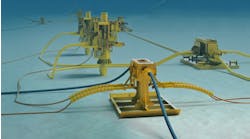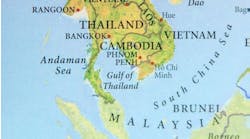Offshore staff
TOKYO – Offshore pre-lay has been completed of the 77-km (48-mi) chain and cable mooring system for INPEX’s Ichthys LNG project in the Browse basin off Australia’s northern coast.
This involved installing 49 chains on the seabed in water depths of up to 250 m (820 ft) and anchored to foundation piles 5.5 m (18 ft) in diameter and 63 m (206 ft) long.
The mooring system should secure the central processing facility (CPF) and FPSO to the seafloor at the Ichthys field location for at least 40 years of continuous operation.
Once at the field, the CPF will deliver natural gas and condensate through an 890-km (553-mi) subsea gas export pipeline to onshore processing facilities in the Northern Territory. Most of the condensate will be processed through the FPSO and shipped directly to market from the field.
Total weight of the anchor chains is more than 40,000 metric tons (44,092 tons) – each chain link weighs more than 700 kg (1,543 lb).
The 28 CPF mooring consignment comprised more than 25,000 metric tons of mainly 178-mm diameter chain, while the 21 FPSO mooring chains, mainly 161-mm diameter, weigh a total of more than 15,000 metric tons (16,534 tons).
Ichthys project managing director Louis Bon said the mooring system pre-lay was a significant undertaking with challenging soil conditions for the piling scope of work.
As the field is 120 km (74.5 mi) from the main hump back whale migratory routes and calving grounds of northwest Australia, an early decision was taken to avoid pile driving during the whale calving period as associated underwater noise may have created a disturbance.
The CPF and FPSO are nearing completion at shipyards in South Korea, after which they will be towed 5,600 km (3,479 mi) to the field.
Aside from the mooring system, more than 16,000 metric tons (17,637 tons) of subsea structures and 140 km (87 mi) of rigid flowlines have been installed for the project.
05/12/2016
Share your news withOffshore at [email protected]


